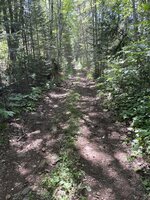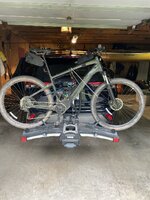michaeljk1963
Member
- Region
- USA
I originally posted part of this in another thread about my recently purchased Specialized Tero 3.0, but thought it should be posted as a separate thread since I wasn't able to find one specifically addressing this topic, which is: what's a good solution for a Satellite-based navigation and communications device for when you are out of cell range that also connects to Specialized Mission Control and Ride apps?
I might also go look for a specialized forum to see what my options are for getting my Tero and a Garmin satellite device to work together, or just contact Specialized support.
I currently own a fairly old Garmin "e20" (I think that's the name). Great little device for navigation, but very small screen. I have used it to help me figure out where I am going in the Boundary Waters Canoe Area Wilderness (my cabin is about 20 miles from there), when you can't tell with observation whether what's in front of you is a peninsula, an island or maybe even an isthmus between two lakes! This will work for me for Mountain biking in a pinch, but for sure, I'd have to stop my bike, take it out, take my reading glasses out (I will be 60 in about 6 weeks), figure out where I am, and then put it away until the next time I am not sure where I am. It doesn't have bluetooth to connect to anything, including my phone, and it doesn't have any kind of communication built in (well, usb port solely for firmware and OS upgrades).
I don't have to go far at all near here (my cabin) to lose reception. There's basically a single highway coming out of Duluth along Lake Superior to Canada (made famous by Bob Dylan--Highway 61), along which there is fairly reliable cell reception, but move even just a few miles from the highway and you lose any signal. My cabin borders the Superior National Forest (I am very lucky that way), which is enormous, beautiful, and ver quicklJust yesterday, my wife and our two collie dogs were hiking up Carlton Peak Trail. There was a faint signal in the parking lot, 1 bar at most. We knew there was a chance of rain, but the Weather app put it at 30%. ½ mile into the hike, no signal. On our way up the trail, the wind picked up, then thunder, then rain, we waited for it to pass for a little while, but then it didn't, and the thunder became more frequent. We turned around, not knowing what to expect, and not wanting to be on the peak if there was lightning.
Here is what I care about: I want to be able to use a reliable map app on my phone when I have no cell signal, I want to be able to send an emergency SOS signal via satellite, and would also prefer weather access, two way messaging, and if possible, have it sync up to my Specialized Mission Control app and Ride app to record my ride. I took the suggestion of @indianajo and bought a Garmin inReach Mini 2. FYI, the link he sent in his recent message is for the inReach Mini, but there is a much improved Mini 2 version, with apparently 3 times the battery life, several new features, better bluetooth connectivity, and the ability to use Garmin's apparently much improved app (Explore rather than Earthmate). I bought my Garmin InReach Mini 2 from REI in case it doesn't end up "ticking all the boxes." Once I get it, I will try to figure out how to connect it to the Specialized Mission Control app, and report on my success or failure. If anyone is currently using this device with their Specialized eBike and can attest to their compatibility, that would be great! I did see that the Specialized Ride app does have an option in Settings for "Connected Accounts" and "Garmin Connect" is one of the options. I just don't know yet if the inReach Mini 2 will let me use Garmin Connect to connect to the Specialized Ride app. Even if it fails at that, if the Garmin Explore app gives me the ability to reliably use their navigation app on my phone that will be sufficient for me (some reviews of the original Mini complained about bluetooth failing on that older device and older app). There were other much more feature-rich satellite GPS devices out there, including the Montana 700, but they are much more expensive, heavier, larger, and don't have nearly the battery life of the inReach Mini 2, and even with a larger screen, I'd still rather use my phone for navigation because I don't have room for yet another device on my handlebars. I'll try the inReach Mini 2 and see how it goes, but if someone around here has a better option to suggest, I am all ears.
I might also go look for a specialized forum to see what my options are for getting my Tero and a Garmin satellite device to work together, or just contact Specialized support.
I currently own a fairly old Garmin "e20" (I think that's the name). Great little device for navigation, but very small screen. I have used it to help me figure out where I am going in the Boundary Waters Canoe Area Wilderness (my cabin is about 20 miles from there), when you can't tell with observation whether what's in front of you is a peninsula, an island or maybe even an isthmus between two lakes! This will work for me for Mountain biking in a pinch, but for sure, I'd have to stop my bike, take it out, take my reading glasses out (I will be 60 in about 6 weeks), figure out where I am, and then put it away until the next time I am not sure where I am. It doesn't have bluetooth to connect to anything, including my phone, and it doesn't have any kind of communication built in (well, usb port solely for firmware and OS upgrades).
I don't have to go far at all near here (my cabin) to lose reception. There's basically a single highway coming out of Duluth along Lake Superior to Canada (made famous by Bob Dylan--Highway 61), along which there is fairly reliable cell reception, but move even just a few miles from the highway and you lose any signal. My cabin borders the Superior National Forest (I am very lucky that way), which is enormous, beautiful, and ver quicklJust yesterday, my wife and our two collie dogs were hiking up Carlton Peak Trail. There was a faint signal in the parking lot, 1 bar at most. We knew there was a chance of rain, but the Weather app put it at 30%. ½ mile into the hike, no signal. On our way up the trail, the wind picked up, then thunder, then rain, we waited for it to pass for a little while, but then it didn't, and the thunder became more frequent. We turned around, not knowing what to expect, and not wanting to be on the peak if there was lightning.
Here is what I care about: I want to be able to use a reliable map app on my phone when I have no cell signal, I want to be able to send an emergency SOS signal via satellite, and would also prefer weather access, two way messaging, and if possible, have it sync up to my Specialized Mission Control app and Ride app to record my ride. I took the suggestion of @indianajo and bought a Garmin inReach Mini 2. FYI, the link he sent in his recent message is for the inReach Mini, but there is a much improved Mini 2 version, with apparently 3 times the battery life, several new features, better bluetooth connectivity, and the ability to use Garmin's apparently much improved app (Explore rather than Earthmate). I bought my Garmin InReach Mini 2 from REI in case it doesn't end up "ticking all the boxes." Once I get it, I will try to figure out how to connect it to the Specialized Mission Control app, and report on my success or failure. If anyone is currently using this device with their Specialized eBike and can attest to their compatibility, that would be great! I did see that the Specialized Ride app does have an option in Settings for "Connected Accounts" and "Garmin Connect" is one of the options. I just don't know yet if the inReach Mini 2 will let me use Garmin Connect to connect to the Specialized Ride app. Even if it fails at that, if the Garmin Explore app gives me the ability to reliably use their navigation app on my phone that will be sufficient for me (some reviews of the original Mini complained about bluetooth failing on that older device and older app). There were other much more feature-rich satellite GPS devices out there, including the Montana 700, but they are much more expensive, heavier, larger, and don't have nearly the battery life of the inReach Mini 2, and even with a larger screen, I'd still rather use my phone for navigation because I don't have room for yet another device on my handlebars. I'll try the inReach Mini 2 and see how it goes, but if someone around here has a better option to suggest, I am all ears.



